
There are plenty of things in this life on which you can’t put a price, but space is not one of them. Virgin Galactic reckons it can help you join the 62-mile-high club for $250,000, while back here on earth, we’re calling it 20 grand, give or take, for the regular kind of space.
That’s the rough difference between what Mazda charges for its top-spec all-wheel-drive five-seater Mazda CX-5 and its bigger brother you see here, the seven-seater Mazda CX-9 Azami flagship.
Okay, they’re not directly comparable because of equipment and tech differences, but engines and transmissions are shared, so it’s not an absurd observation: those two small seats in the third row amount to around $10,000 each. But to plenty of Aussie families, they’re so invaluable they actually are hard to put a price on.
We reckon the current mainstream leaders of the seven-seater SUV segment are this pair – the Mazda we anointed as our 2017 COTY and the newly minted fourth-gen Kia Sorento. But first, we need to address the model choices we’ve gone for here.
The Mazda CX-9 line-up offers just one engine choice, the 2.5-litre SkyActiv G delivering 170kW and 420Nm, so that was easy. Kia’s Sorento is (at least until hybrids arrive in 2021) available with both petrol (a 3.5-litre non-turbo V6 making 200kW and 332Nm) or our choice here, the 2.2-litre four-cylinder turbo-diesel making 148kW and 440Nm.
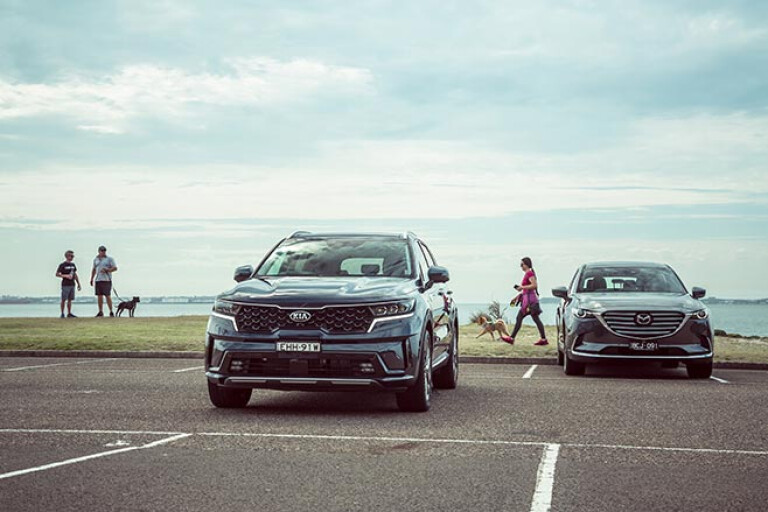
We wanted the flagship all-wheel-drive variants of both models, and the Sorento is engineered to drive only the front wheels when the petrol V6 is chosen.
Which is why we have these two, both with turbocharged four-cylinder engines within around 300cc of each other, both driving all four wheels, but burning very different fuel grades.
Yet, as we’ll get to shortly, the net result, at least in terms of acceleration and overtaking ability, is remarkably comparable.
So, as they line up here, the Kia grabs a handy (on paper) price advantage. If you’re shopping at this flagship end of the respective line-ups, it’s possible you’re not the most hardcore pragmatist in the showroom, but you still can’t ignore that the Sorento GT Line retails for $64,990 drive away, while the Azami AWD asks $69,303 plus on roads.
Assuming no haggling, that’s around a $7K advantage to the Kia. But a quick browse online shows Mazda dealers offering the top-spec CX-9 for around $65,000 driveaway, pretty much line-ball with Kia’s range-topper.
As a quick aside, if we had insisted both cars were petrol-burners, we would have seen the Kia Sorento GT-Line FWD at $61,990 (driveaway) up against the front-drive Mazda CX-9 Azami at $64,893 (plus on-roads), so a circa-$5000 advantage to the Kia, at least purely at retail.

Fact is, while the CX-9 Azami is a beautifully trimmed and carefully crafted SUV, it just doesn’t give a sense of being appreciably more expensive than the Kia when you slide behind the wheel.
You could argue that some of the Mazda’s materials feel higher quality, but the execution of the Sorento’s high-definition screens, crisp graphics and cabin design flourishes instantly make it feel a couple of generations more contemporary, and definitely not the dowdy budget alternative.
Other small-sounding but notable differences: the driver’s seat of the Sorento includes electrically adjustable under-thigh support, instantly making it the more comfortable of the two cars for taller owners.
Then there’s the multi-configurable digital instrument panel in the Kia; again a generation on from the more conventional display in the Mazda, which uses a TFT speedo flanked by conventional analogue gauges.
And the 9.0-inch colour infotainment screen poking out of the Mazda’s dash (controlled by a rotary knob, or touch when stationary) looks kinda dinky against the 10.25-inch touchscreen in the Kia.
Both cars offer ample oddment storage, but it’s the Kia that delivers a larger lidded front tray (with wireless phone charging) and a bigger, deeper centre console box.
As for comfort and convenience, they’re closely aligned. Both have heated and cooled front seats, heated steering wheels, heated (outboard) rear seats, head-up displays, vast glass roofs, premium Bose audio, power tailgates, and roll on 20-inch wheels with same-width (255mm) tyres.
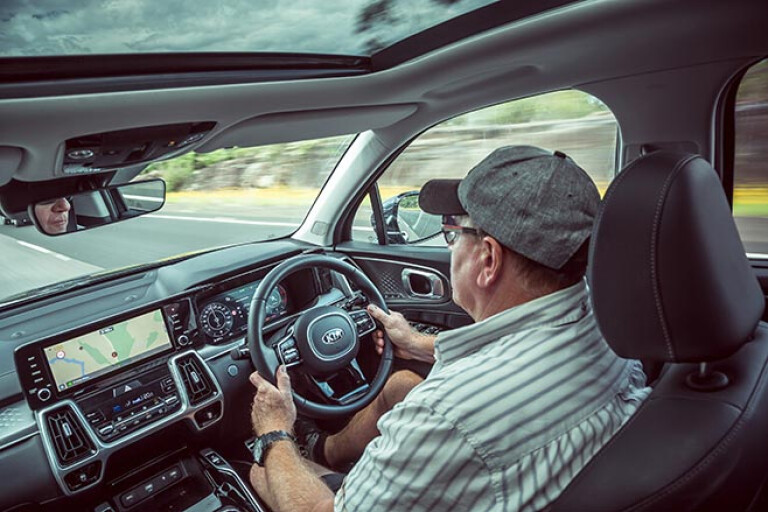
The Kia’s ‘advantages’ amount to stuff that’s nice, but unlikely to see regular use, like the ability to alter the interior lighting across virtually the entire colour spectrum, or play preset ambient sounds through the audio system, like gentle surf or rain of the roof.
Oh, and if the kids in the third row are giving you grief, you can admonish them via the ‘intercom’ system, which directs your shouty-parent voice to the rear-most speakers.
And let’s not forget Remote Parking Assist, so if the car is parked in tight confines and you can’t easily get in, you can stand outside and use buttons on the fob to reverse it out in a straight line; a handy feature the Mazda can’t match.
You could toss a coin to try and split this pair when it comes to second-row access, comfort and amenity. Start sizing up the third rows of this pair, though, and it becomes more a case of pros and cons.
The airiness and side-window size in both cars is comparable, while one-touch buttons in each flip the second-row seatbacks forward, slide the base, and rise slightly to make more room.

The Mazda’s main trump is a marginally wider-opening aperture into the third row, and helpfully putting the 40-percent section of the 60:40 split-fold seat on the kerbside.
The Kia makes it a bit more of a gymnast’s squeeze to get in there with dignity intact, and adds the extra weight of the larger section of seat on the kerbside.
Once seated, passengers back there approaching 170cm will see knees bent at a pretty accurate angle, and the Mazda strikes out by not providing ventilation.
The Kia, on the other hand, provides vents and fan-speed control.
Will the small kids who will be the most frequent occupants of the third rows throw a mutiny because they can’t direct 22-degree air at their pudgy faces? Probs not, but we’ve still gotta call it as a split (fold) decision.
Comparing boot space, that outcome swings Sorento’s way, mostly by virtue of Kia’s decision to locate the full-size spare outside the car under the cargo floor.
Mazda goes the more conventional route of sticking a space-saver inside below the removable boot panel, so CX-9 can’t match the extra sub-floor storage cubbies in the Sorento, which also cleverly provides storage there for the luggage blind.

Meanwhile, with both second and third rows folded, the most hardcore of Bunnings raiders will find the respective capacities of both SUVs vast, but still heavily favour the Kia, with 2011 litres versus the Mazda’s 1641 litres.
But enough about accommodation, what about on the road? In undemanding urban driving, they’re both similarly excellent.
But the first caveat that has to be covered, especially if you’re a bit NVH OCD (look it up; it’s a thing), is the idle and low-rev noise of the Kia’s diesel.
Hit the start button and you’ll hear a suppressed but still recognisably diesel clatter, and feel a small band of vibration through the wheel.
The idle noise is actual better suppressed than the four-pot diesels of a couple of premium brands, so kudos to Kia there, but the unavoidable thermodynamic fact is the Korean compression-ignition engine can’t get close to the near-inaudible and vibration-free idle of Mazda’s petrol-burner.
Likewise when on and off the throttle around the burbs; the Kia’s engine is omnipresent, even if the vibes do smooth out on the move, and the soundtrack becomes more gravel, less clatter.
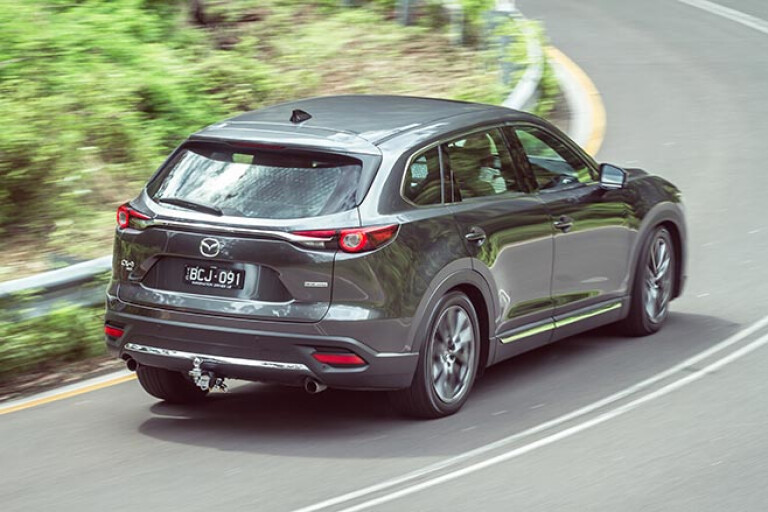
The Mazda’s engine, meanwhile, is barely perceptible on a light throttle around town, and transitions sweetly to an eager, tuneful mid-range.
The curious bit is both engines are similarly responsive and alert to the throttle, ensuring this pair never feel like lumbering Goliaths, they just sound very different in how they go about dealing with the daily grind.
As for accelerative abilities, overtaking grunt and general open-road touring prowess, they’re virtually impossible to split.
From jogging pace to 140km/h under wide-open throttle, neither claws an advantage; likewise when overtaking between 80-120km/h.
The biggest difference comes back to response speed of the respective transmissions. The Kia’s eight-speed dual-clutch can grab its optimum ratio faster than the six-speed torque-convertor auto of the Mazda, making it feel the swifter of the two.
Then there’s the not-inconsequential fact that the Kia provides paddle shifters for manual control, further increasing the ease to pluck the right ratio for any given situation.
The lack of paddles on the Mazda can be a bummer for the keener driver, but at least when the transmission lever is pushed over into its manual position, the CX-9’s shift pattern (as with all Mazdas) is the correct orientation of push-for-downshift.
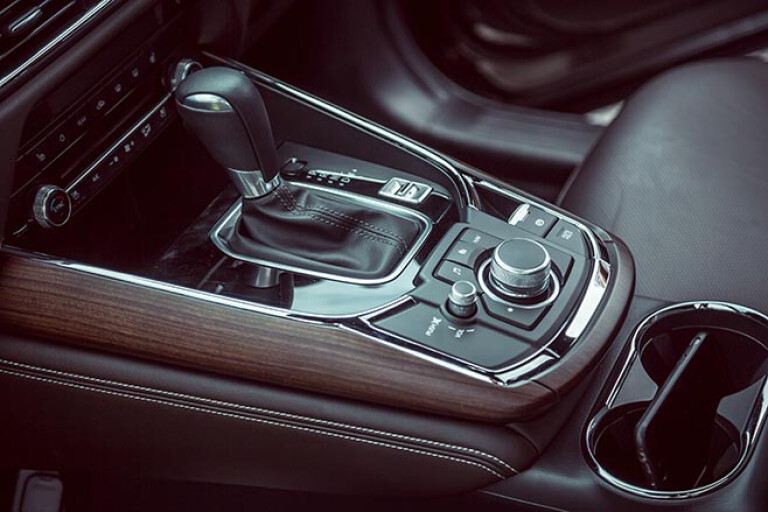
And you will rely on the manual mode on the occasions you want to really push the Mazda, because the only other drive mode is a Sport setting that tends to hold onto ratios too resolutely when the pace has to settle back down for any brief period.
This two-drive mode approach for the CX-9 contrasts with the Kia, which provides Comfort, Eco, Sport and Smart, as well as three modes for off-road driving (which we’re yet to try).
Sport adds weight to the steering, which is of debatable benefit in fast driving and has no bearing on suspension tune, as the Sorento runs fixed-rate dampers (as does the Mazda).
Consumption-wise, you would expect the Kia’s diesel to be more frugal, and so it proved, using 8.8L/100km on test (its official number is 6.1) against the Mazda’s 10.4L/100km (against a combined Australian Design Rules figure of 8.8L/100km).
Which brings us to chassis dynamics, and perhaps the greatest curveball of this comparison. In isolation, the Mazda remains a really well-resolved large SUV, and one where driving satisfaction hasn’t been abandoned in the quest for occupant space and light off-road ability.
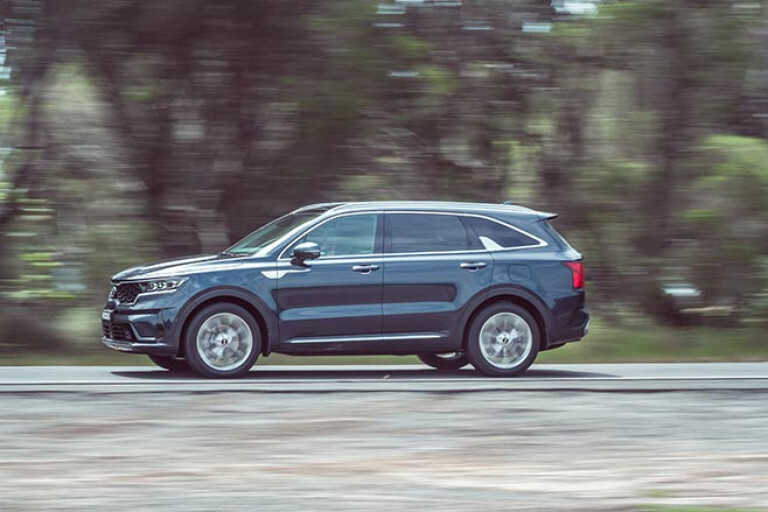
Remember, its 2017 COTY win was the eighth for the innovative Japanese brand, and at the time veteran Wheels road-tester Nathan Ponchard wrote that “this seven-seat SUV is so vastly superior to the competition, you’d need to stretch to a premium SUV like Audi’s superb Q7 to try and better it – for double the price...”
Improvements to the CX-9 for MY20 include an upgraded G-Vectoring Control Plus (GVC-Plus) system, which uses brake control to vector torque as the CX-9 exits a corner to help stabilise the transition to straight-line running while improving steering feel and consistency.
There’s also now a button to engage the new ‘Off-Road Traction Assist’ function, which turns the CX-9 into more of a full-time all-wheel drive than an on-demand one.
Effective at all speeds, its ability to send more drive to the rear (and lessen front-wheel torque-steer) is useful when accelerating hard from T-junctions or driving the CX-9 briskly on twisty roads.
But Kia arrives in this space having gone all-out with its rival, giving Sorento a new platform that has gifted the local suspension development team a really fine foundation on which to tune the car.
It turns in with even greater crispness than the CX-9, feels a little less nose-led in tight terrain, and more immune to front-end flightiness over fast undulations.

There’s a strong sense that Sorento’s Continental rubber is less squirm-prone than the Falkens fitted to the CX-9, further enhancing the Kia’s four-square planted feeling, and the fluid, ultra-confident cornering demeanour.
Over pock-marked surfaces, the CX-9 holds a slim ride advantage; how much of this might be attributed to the marginally taller sidewalls of the Falkens (50-series, versus 45-series for the Kia’s Continentals) is impossible to say.
Both cars are more surface-sensitive than their lower-spec siblings on 19s and can feel jittery over low-speed rough stuff.
If you place a high priority on ride comfort, consider asking your dealer to replace the 20-inch wheels with rolling stock an inch (or two) smaller.
The CX-9 retains all the virtues that pushed it to COTY victory in 2017. In this specification, it feels premium, with great attention to detail, while its powertrain is a standout for smoothness, quietness and muscularity where you need it.
The dynamics remain good enough that when driven hard in isolation it feels alert, confident and responsive. And the cabin accommodates big families, with generous room, great comfort and amenity.

But the current CX-9 was first unveiled at the LA auto show way back in 2015, and Kia has had its developmental throttle pinned for much of that period, making big leaps with each successive model, arguably none greater than here.
The Sorento’s multimedia display, the modernity of the dash, its extra warranty (seven years versus five for the Mazda) all may be enough to sway customers.
The on-road attributes become more a question of priorities – quieter, smoother operation for the Mazda thanks to petrol power, versus slightly less road noise at touring speeds for the superbly insulated Kia, which also holds the outright dynamics trump card.
With hybrid-petrol versions of the Sorento coming, the CX-9’s AWD powertrain refinement edge will be further challenged. Here and now, by a small margin, Korea edges ahead of Japan in this space race.
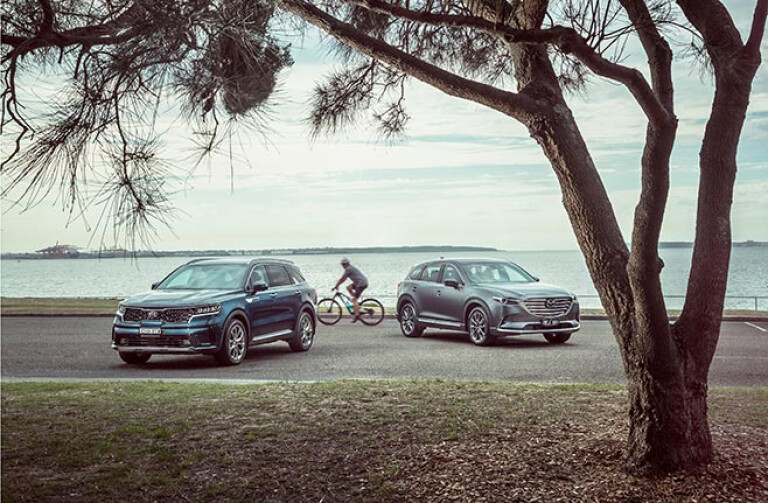
All that you leave behind: Kia’s Cameras help you out of a (blind) spot
Kia calls its camera system Blind Spot View Monitor, and it’s not a new concept. Honda offered something similar in the HR-V small SUV in 2016.
In the Sorento (top-spec GT-Line only), an application of the indicator stalk instantly projects a camera image of the blind-spot area onto the instrument panel.
It’s framed as a circle, and replaces the speedo when showing the left-hand side, or the tacho on the right. It’s cool tech, but we’re yet to encounter a situation where it has proven its worth.
Life out back
The second rows of both SUVs are similarly well-specced and comfortable.
Their seat bases and split-fold backrests are adjustable, so if the third row is in use you can tailor the space depending on the legroom requirements of all occupants.
Or if the third row is folded, configure the boot for maximum luggage space if those in the second row are shorties. Both cars also provide climate control, USB ports and seat heating, so expect minimal whinging from back there. Maybe.
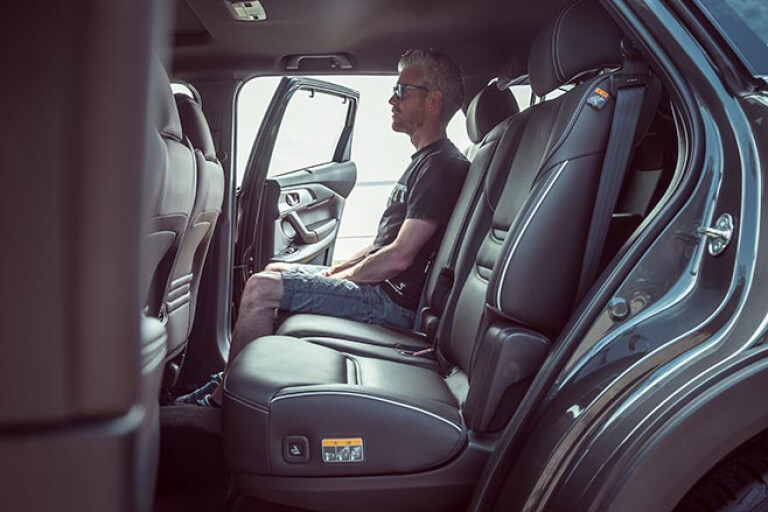
Three things (each) to note
Kia Sorento
1. Hands off(ish)
As well as lane-keep assist, which warns you of inadvertent lane wandering via steering-wheel vibration, Sorento also has ‘lane follow assist’, which actively steers the car within marked lanes. It’s often useful, but not completely infallible.
2. Crazy diamond
That diamond texturing on the Kia’s door trim panels and dash allows the ambient interior lighting to shine through. Choose from a bunch of preset colours, or create your own cool hue via the colour wheel within the multimedia menu.
3. Nice kind of knob
Kia’s transmission selector is a large circular knob, similar to that which Jaguar introduced around 2012. It works fine, and its low profile aids access to the lidded front storage bin, which also houses the wireless phone-charging pad.
Mazda CX-9
1. Wood if it does
Much of the Mazda’s trim materials look and feel a little more premium than those of the Kia when you really inspect closely, and CX-9’s timber trim accents in the doors and centre console add a richer but more conservative ambience.
2. World’s a stage
Both cars feature excellent Bose audio systems, but the Mazda doesn’t have the Kia’s extra tweeters mounted in the A-pillars, so can’t quite match the broader, more natural soundstage for vocals delivered by the Sorento.
3. Back for thirds
Just out of sight here is the all-important third row, which is a little easier to access in the CX-9, thanks partly to the smaller, lighter section of the split-fold backrest on the kerb side. Shame about the lack of ventilation in the third row, though.
Kia Sorento vs Mazda CX-9 specs
|
| Kia Sorento GT-Line | Mazda CX-9 Azami |
|
| $63,070 | $69,303 |
|
| Drivetrain |
|
| Engine | 4cyl, dohc, 16v, turbo-diesel | 4cyl, dohc, 16v, turbo |
| Layout | front engine (east-west), AWD | front engine (east-west), AWD |
| Capacity | 2151cc | 2488cc |
| Power | 148kW @ 3800rpm | 170kW @ 5000rpm |
| Torque | 440Nm @ 1750-2750rpm | 420Nm @ 2000rpm |
| Gearbox | 8-speed dual-clutch | 6-speed automatic |
|
| Chassis |
|
| Body | steel, 5 doors, 7 seats | steel, 5 doors, 7 seats |
| L/W/H/W–B | 4810/1900/1700/2815mm | 5075/1969/1747/2930mm |
| Track (F/R) | 1637/1647mm | 1663/1663mm |
| Weight | 1908kg | 2006kg |
| Boot | 616 litres | 810 litres |
| Fuel/tank | diesel/67 litres | petrol/74 litres |
| Economy | 8.8L/100km (test average) | 10.4L/100km (test average) |
| Suspension
| Front: struts, coil springs, Rear: multi-links, dampers, | Front: struts, coil springs, Rear: multi-links, dampers, |
| Steering
| electric rack-and-pinion | electric rack-and-pinion |
| Front brakes | ventilated discs (325mm) | ventilated discs (320mm) |
| Rear brakes | ventilated discs (325mm) | solid discs (325mm) |
| Tyres | Continental PremiumContact 6 | Falken Ziex CT50 |
| Tyre size | 255/45 R20 (f/r) | 255/50 R20 (f/r) |
|
| Safety |
|
| ANCAP rating | Not tested (Aus) | Five stars |
| Verdict | 8.5/10 | 8.0/10 |
|
| Warranty: 7yr/unlimited km. | Warranty: 5yr/unlimited km. |



COMMENTS